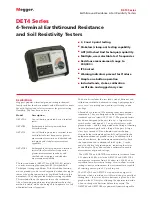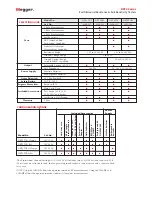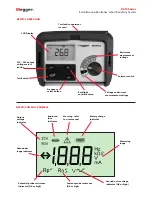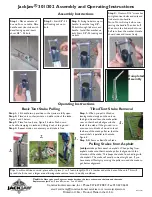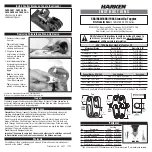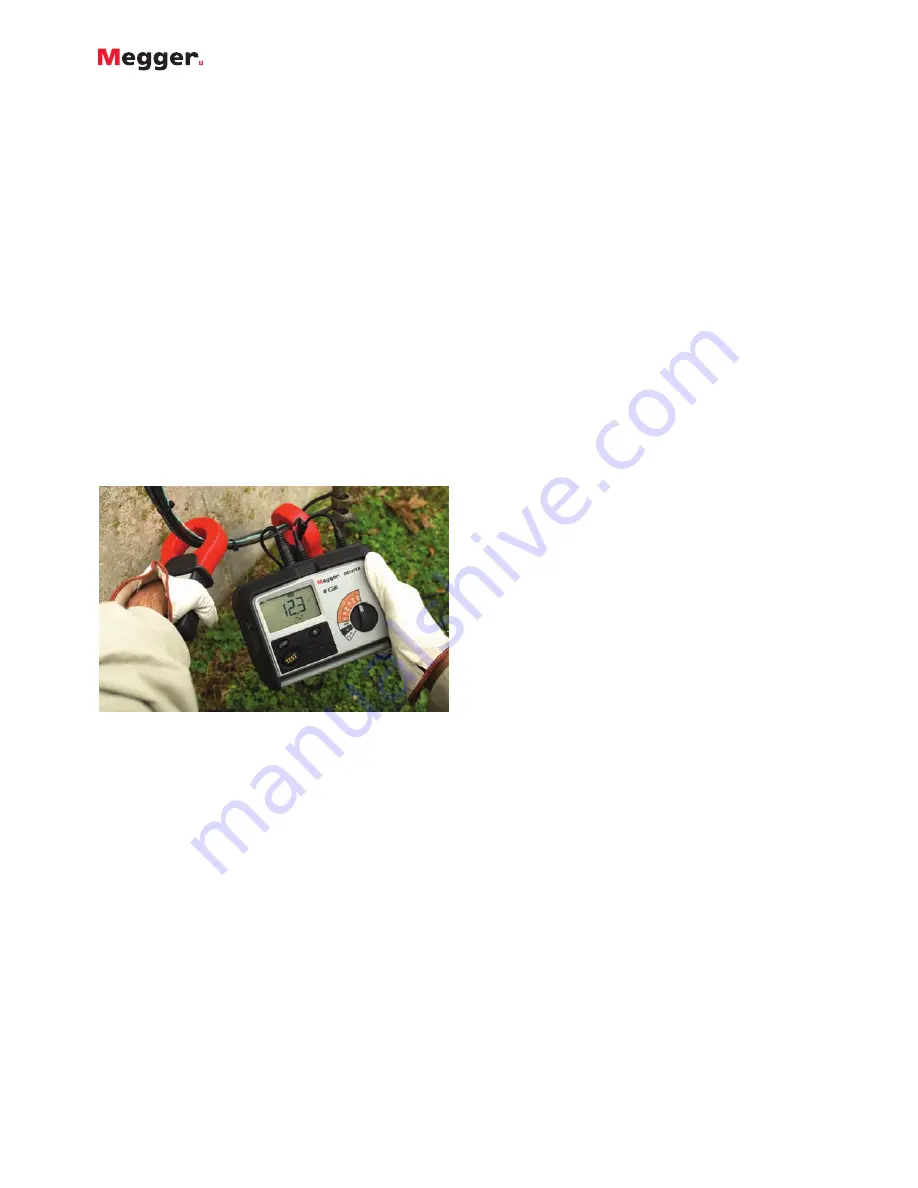
DET4 Series
Earth/Ground Resistance & Soil Resistivity Testers
AA cells. The battery charger is built in and the instrument
is supplied with an AC/DC adapter. For all instruments, the
battery status is displayed using a bar-graph.
The DET4TC2 and DET4TCR2 include additional
capabilities. By using the optional ICLAMP the user can
augment the traditional fall-of-potential measurement
method with ART (Attached Rod Technique), which allows
electrode testing without disconnection and also leakage
current measurements down to 0.5 mA. A second optional
clamp, the VCLAMP, enables true stakeless (clamp-on)
measurements to be made in situations where driving
stakes is not practical.
The DET4TC2 and DET4TCR2 also feature a backlit
display, which extends the operational environment of
the instrument to cable cellars and other dark locations.
Finally, all units have selectable 25 V or 50 V output for
compliance with IEC 61557-5. The 25 V output is required
for testing in agricultural environments.
The maintenance of an adequate low resistance ground
connection is essential to both the protection and
performance of any electrical system. Ground testing
should be performed both upon installation, to meet
design specification, and periodically thereafter in order
to maintain service. All Megger models can also perform
bonding tests (using an ac signal), to determine that
adequate connection has been made from equipment to
the grounding system, and can perform soil resistivity
tests. This additional function can be used in prospecting,
locating, and designing new grounding electrodes and
systems. Furthermore, the addition of built-in current
clamp capability enables fall of potential testing of attached
grounds (ART) without lifting the utility connection and
the addition of voltage clamp technology enables stakeless
testing from the same instrument.
Grounding electrodes from simple to complex systems can
be tested, including:
n
Primary and secondary electrical grounding systems
n
Utility pole grounds
n
Lightning protection systems
n
Residential grounds
n
Machinery safety grounds
n
Computer and communication system grounds
n
EMI/RFI system grounds
n
Antenna and pedestal grounds
n
CATV system grounds
FEATURES AND BENEFITS
n
Stakeless testing
capability, which allows the operator
to use the instrument like a clamp-on tester in applica-
tions where the method is viable
n
Attached Rod Technique
capability, which allows fall
of potential testing without the need to disconnect the
ground rod
n
Multiple, user selectable test frequencies allows the
operator to find the most effective frequency for making
the measurement
n
200,000
Ω
measurement range provides the ability to
measure the resistivity of any type of soil
n
User selectable test voltage ensures that the units can be
used in agricultural environments
n
Microprocessor control for improved error detection
n
Clear, unambiguous warnings and error indications en-
sure the reliability of the reading and reduce test time
n
Rugged, weatherproof case to IP54 makes the units truly
outdoor instruments
n
Backlit LCD allows for testing in dark environments
n
Noise rejection to 40 V pk to pk allows accurate testing
in noisy environments
n
Testing kits and certificates supplied — everything
needed to start testing immediately
n
Accuracy of 2% of reading enhances reliability of mea-
surements
n
Voltmeter function included allows you to measure the
ground voltage and enhances operator safety
n
CAT IV 100V provides increased operator safety
Model DET4TCR2 shown performing the stakeless ground testing method
using only clamps.
APPLICATIONS
Proper grounding provides many varied benefits to both
people and facilities. It lessens the chance of injury due
to faulty installation, reduces the likelihood of damage
from lightning strikes and induced voltages, improves
the performance of computer, communication and other
sensitive equipment and protects against static electricity
from friction. Over time, ground systems can degrade or
become ineffective. Corrosion and weather influences
exert mechanical strain on ground rods and cause metallic
corrosion. Catastrophic events like lightning strikes or large
fault currents can cause instant degradation. In addition,
soil resistivity can change over time due to environmental
conditions and facility expansion can create different
ground system needs.
The risks from ground system deterioration include
potentially deadly electrical shock situations, plant-wide
equipment damage, disruption in the performance of
sensitive equipment and heat build-up on a single piece of
electrical equipment.

